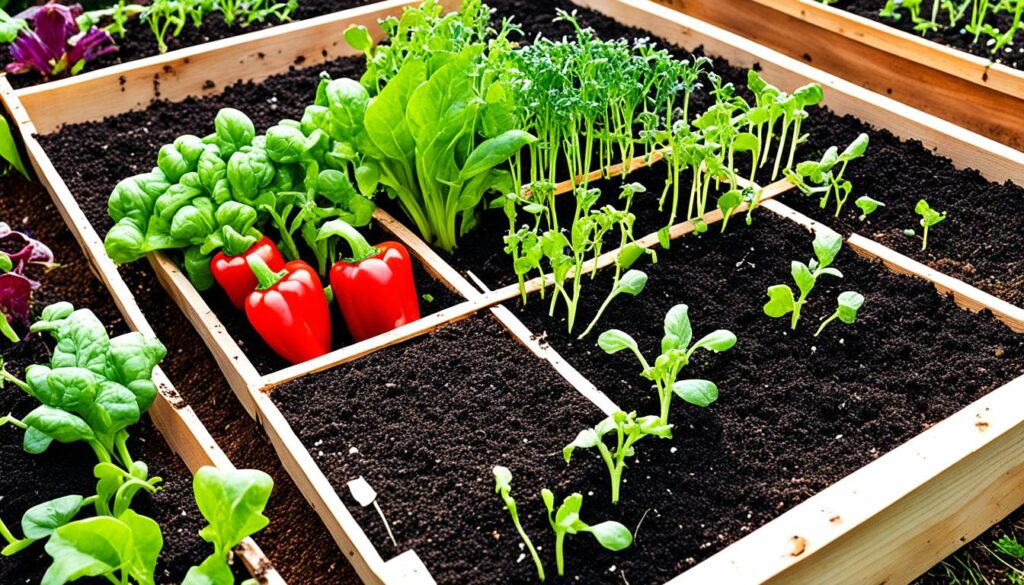Raised Bed Gardening for Beginners: Starting Your First Garden
Are you a beginner gardener looking to start your own vegetable garden? Have you considered raised bed gardening as a simple and efficient way to grow your own food? If so, you’re in the right place! In this article, we will guide you through the basics of raised bed gardening and show you how to get started on your first garden.
Key Takeaways:
- Raised bed gardening is a great option for beginners who want to start their own vegetable garden.
- The fall is often the best time to start building a raised bed garden.
- You can use various materials to build a raised bed garden or buy pre-made ones.
- Proper soil preparation and choosing the right location are crucial for successful raised bed gardening.
- With regular maintenance and care, you can enjoy a bountiful harvest of fresh and healthy vegetables.
Designing Your Raised Bed Garden
Designing your raised bed garden involves careful consideration of the location, size, shape, and layout of your beds. By following these steps, you can create a functional and visually appealing garden that optimizes productivity and plant health.
Choosing the Right Location
Start by selecting a sunny spot for your raised bed garden. Most vegetables require at least 8 hours of sunlight per day to thrive. Look for an area with good exposure to the sun throughout the day. Additionally, consider the proximity of your water source, as raised beds will need regular watering.
Determining Bed Size and Shape
The size and shape of your raised beds will depend on several factors, including the available space and the types of plants you want to grow. For most vegetables, a depth of 10-12 inches is recommended to ensure adequate root development. However, certain root crops or plants with deep root systems may require deeper beds. Consider the space you have and plan the number and size of your beds accordingly.
Planning Your Layout
Efficiently planning the layout of your plants is key to maximizing space and ensuring proper plant growth. Start by researching the spacing requirements of the vegetables you intend to grow. This will help you determine how many plants can fit in each bed and how far apart they should be planted. Consider companion planting techniques to enhance plant growth and deter pests naturally. Additionally, make sure to leave enough space for pathways between beds for easy access and maintenance.
“A well-designed raised bed garden allows for optimal plant growth and efficiency while creating a visually pleasing and organized space.” – John Smith, Master Gardener
Using the Kitchen Garden Planner
To simplify the process of designing your raised bed garden, consider using the Kitchen Garden Planner tool. This online resource allows you to visualize and plan your garden layout, experiment with different bed sizes and shapes, and explore companion planting options. It can greatly assist in creating a well-structured and productive garden.
| Designing Your Raised Bed Garden | Tips and Recommendations |
|---|---|
| Choose a sunny location | Ensure your raised bed garden receives at least 8 hours of sunlight per day. |
| Determine bed size and shape | Consider the available space and the types of plants you want to grow. Aim for a depth of 10-12 inches. |
| Plan your layout | Research spacing requirements and companion planting techniques to optimize space and plant growth. |
| Utilize the Kitchen Garden Planner | Use this online tool to visualize and plan your raised bed garden layout. |
Choosing the Best Vegetables for Your Raised Bed Garden
When it comes to raised bed gardening, selecting the right vegetables is key to a successful and rewarding experience. Consider your climate and growing conditions to ensure that the vegetables you choose thrive in your raised bed garden. Some popular options for raised bed gardening vegetables include:
- Tomatoes: This versatile fruit (yes, tomatoes are technically a fruit) is a favorite among gardeners. From juicy beefsteak varieties to sweet cherry tomatoes, there’s a tomato for every taste.
- Peppers: Whether you prefer the mild crunch of bell peppers or the spicy kick of chili peppers, growing your own peppers in a raised bed garden is a great way to add flavor to your meals.
- Cucumbers: Crisp and refreshing, cucumbers are an excellent choice for raised bed gardens. They can be trellised to save space and make harvesting easier.
- Lettuce: Leafy greens like lettuce are perfect for raised beds. They can be grown close together and are quick to mature, allowing you to enjoy fresh salads all season long.
- Spinach: Another leafy green powerhouse, spinach is packed with nutrients and adds a delightful, earthy flavor to salads, smoothies, and cooked dishes.
- Carrots: Root crops like carrots thrive in raised beds with loose, well-draining soil. Enjoy the satisfaction of pulling up vibrant orange carrots from your own garden.
- Herbs: Basil and parsley are popular choices for raised bed gardens. Their aromatic leaves can elevate any dish, and they can be grown alongside your other vegetables.
While these vegetables are well-suited for raised beds, don’t be afraid to experiment with other options based on your personal preferences and the specific needs of each plant. Before making your final selections, research the growing requirements of different vegetables, such as soil type, sunlight, and watering needs, to ensure their successful growth in your raised bed garden.
To maximize the use of space in your raised bed garden, consider providing support for climbing plants like tomatoes or cucumbers. This allows them to grow vertically and frees up valuable ground space for other vegetables.

With careful planning and thoughtful selection of vegetables, your raised bed garden will yield a bountiful harvest of fresh and delicious produce that you can enjoy throughout the growing season.
Maintaining and Caring for Your Raised Bed Garden
Proper maintenance and care are essential for the success of your raised bed garden. Here are some raised bed gardening tips to help you keep your garden thriving:
- Regular watering: Raised beds can dry out faster than in-ground gardens, especially during dry periods. It’s important to water your plants regularly, providing them with the right amount of moisture they need to grow and flourish.
- Mulching: Use mulch to help retain moisture in the soil and suppress the growth of weeds. Apply a layer of organic mulch, such as straw or wood chips, around your plants to conserve water and prevent weed competition.
- Pest and disease control: Regularly monitor your plants for pests and diseases. Inspect them thoroughly and take appropriate measures to control and prevent infestations. Consider using organic pest control methods, such as handpicking insects or applying natural pest repellents.
- Weeding: Keep your raised bed garden free of unwanted plants by regularly removing weeds. Weeds can compete with your plants for resources and hinder their growth. Use a hand tool or pull weeds by hand, making sure to remove their roots to prevent regrowth.
- Fertilization and soil amendments: Depending on the needs of your plants, you may need to fertilize your raised bed garden. Apply organic fertilizers or compost to provide your plants with the necessary nutrients for healthy growth. Additionally, consider incorporating soil amendments like compost or aged manure to improve soil fertility and structure.
Observing and learning from your garden’s progress will also help you make adjustments and improvements for future seasons. Keep track of what works best for your raised bed garden, and don’t be afraid to experiment with different techniques and methods.

Quote:
“A well-maintained raised bed garden ensures healthier plants and a greater harvest. By taking the time to water, mulch, control pests, weed, and provide proper nutrition, you can create an environment where your plants thrive and flourish.”
– Gardening expert, Jane Mitchell
Conclusion
Raised bed gardening provides numerous benefits for beginners looking to start their own vegetable garden. One of the key advantages is the ability to create a controlled and manageable environment for your plants. By building raised beds, you can easily control the soil quality, moisture levels, and overall conditions for optimal plant growth.
An important aspect of successful raised bed gardening is the soil mix. Using a combination of topsoil and compost in your raised bed gardens promotes proper drainage, prevents waterlogged soil, and enriches the soil with essential nutrients. This nutrient-rich soil mix ensures that your plants have the necessary elements for healthy and vigorous growth.
Another benefit of raised bed gardening is the efficient use of space. With raised beds, you can maximize your gardening area by planting crops closer together without competing for space with weeds. This allows you to grow a greater variety of vegetables and maximize your harvests.
To achieve the best results with raised bed gardening, it’s essential to plan, maintain, and care for your garden properly. Starting small and learning from your experiences will help you adapt your methods and optimize your garden’s performance. With the right approach, raised bed gardening can reward you with an abundance of fresh and healthy vegetables to enjoy throughout the growing season.
If you ever happen to be in our neck of the woods please stop and say Hi at The Landscape Connection and if you would like to see more on this subject and many others visit Michelle at the youtube channel @GardeningTLC
FAQ
What is raised bed gardening?
Why is raised bed gardening recommended for beginners?
When is the best time to start building a raised bed garden?
What materials can I use to build a raised bed garden?
Can I buy pre-made raised bed gardens?
How should I prepare the ground before filling my raised bed garden?
What type of soil mix should I use for my raised bed garden?
What should I consider when designing my raised bed garden?
What vegetables are suitable for raised bed gardening?
How should I maintain and care for my raised bed garden?
What are the benefits of raised bed gardening?
- Disclosure: This article contains affiliate links, which means we may receive a commission if you click on a link and purchase something that we have recommended. Please note that all opinions are our own, and we only recommend products and services that we believe will add value to our readers. Thank you for supporting The Landscape Connection and our site:growingourgarden.com!
- 10 Must-Have Blooms for Your 2025 Garden
- The Health Advantages of Gardening You Need to Know
- How to Create a Small Vegetable Garden Layout Plan: A Beginner’s Guide
- DIY Garden Projects for Small Spaces: Upcycling Ideas to Maximize Your Garden
- Watering Techniques for Small Gardens: Ensuring Your Plants Thrive
- Small Border Plants for Landscaping: Adding Beauty and Functionality to Your Garden
- Year-Round Small Space Gardening: Seasonal Planting Tips for Maximum Harvest
- Essential Tools for Small-Space Gardening: What You Really Need
- The Ultimate Guide to Container Vegetables: What to Grow in Small Spaces
- Budget-Friendly Gardening: How to Create a Thriving Garden on a Tight Budget
- How to Optimize Sunlight in Small Gardens: Tips for Better Plant Growth
- DIY Vertical Planters: Creative Ideas for Small Space Gardening
- Companion Planting for Small Vegetable Gardens: Boost Growth and Deter Pests
- Container Gardening Essentials: Choosing the Right Pots, Soil, and Plants
- Vertical Gardening Techniques: Maximizing Your Small Space with Climbers and Vines
- How to Build a Raised Bed Garden in a Small Backyard: Step-by-Step Guide
- The Best Vegetables for Small-Space Gardens: High-Yield Varieties You Need to Grow
- Smart Vegetable Garden Layouts for Small Spaces: Maximizing Your Green Thumb in Compact Areas
- 40. Best Practices for Managing a Sustainable Garden Year-Round
- Building a Wildlife Pond for Biodiversity
- Advanced Techniques in Sustainable Gardening
- How to Create a No-Till Garden
- The Mental Health Benefits of Gardening
- Using Technology to Enhance Sustainable Gardening
- Getting Certified Organic: Steps and Benefits

Leave a Reply